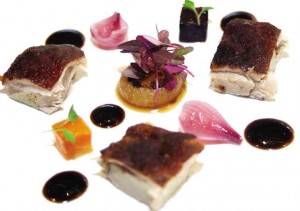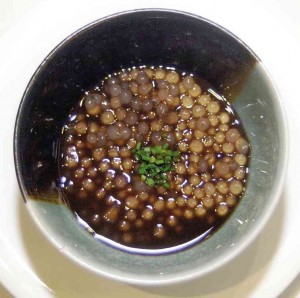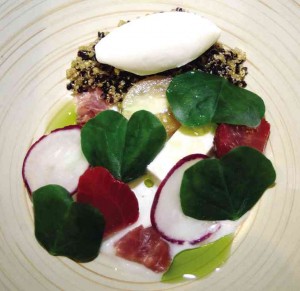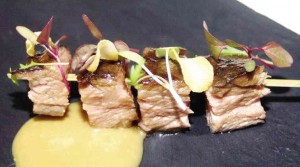Filipino haute cuisine tickles CEOs’ fancy
In today’s world of multinationals and global partnerships, executives and entrepreneurs are often tasked with entertaining foreign guests.
I am often asked to recommend a Filipino restaurant, but here’s a tip: you don’t necessarily have to bring your guests to a Filipino-themed restaurant for them to be introduced to Filipino flavors.
Case in point: I always recommend Mamou, known as a steakhouse, because it also offers Filipino dishes using global ingredients, like the Kurobuta sinigang, or foreign dishes using excellent Pinoy delicacies, like the Batac Bolognese.
At Eastwood, Chef Jessie Sincioco’s 100, a revolving restaurant that offers a 360 ° view of the Manila skyline, serves Filipino dishes using French techniques: balut soup, a bangus belly roulade and ostrich salpicao.
Over at the Fort, The Goose Station serves Filipino haute cuisine: a degustation of Filipino food inspired by the life and writings of Philippine national hero, Jose Rizal. The Goose Station calls it Filipiniana cuisine.
“[We use] culture and heritage as a starting point for creativity and innovation. Local ingredients and traditional techniques are then integrated into the inspirational concept in order to create a new variety of Filipiniana cuisine,” the menu reads.
Indigenous inspiration
It is highly recommendable for foreign guests, especially jetset foodies who have dined at the Robuchons around the world, for a gentle and elegant introduction to Filipino flavors using cooking techniques practiced in the world’s top restaurants. That the menu was inspired by the life of Rizal also makes for good conversation and a great introduction to Philippine history, culture and character as well.
But the Rizal Menu is also highly recommendable for Filipinos, to rediscover Filipino dishes presented in such unusual fashion (foie gras taho, anyone?) as well as to get reacquainted with the life and philosophies of our very own national hero.
The eight-course degustation is well thought out and incredibly inspired. It feels like flipping through pages of a history book, each item expressing a point in time of Rizal’s life.
It starts with a coconut and crab salad inspired by the Tagalog proverb that inspired Rizal (and often mistakenly attributed to Rizal), “Ang hindi marunong lumingon sa pinanggalingan ay hindi makakarating sa paroroonan.”
I took to historian (and Inquirer columnist) Ambeth Ocampo for further enlightenment on this quotation and was delighted to discover that beyond the famous Noli Me Tangere and El Filibusterismo, Rizal can also be credited with writing the first historical work on the Philippines by a Filipino: his version of Lt. Gov. Antonio de Morga’s Sucesos de las Islas Filipinas, after his friend, Austrian ethnographer Ferdinand Blumentritt, failed to accept his request to write a “complete history of our country, judged from impartial criteria.” “[Rizal] realized the importance of the past as a tool to understand the present and eventually confront the future,” Ocampo explains in his book Meaning and History: The Rizal Lectures.
Indeed, this salad puts to the fore true Filipino flavors: the delightful freshness of Philippine crab, the distinct sweetness of cashew nuts, and—this blew me away—a punctuation of latik (coconut oil on the menu) that just peeps on the palate in the end. It is a gentle and sweet “Mabuhay!”
Life of Rizal
After the sweet hello, the menu moves on to Rizal’s life.
Dish No. 2 is inspired by Rizal’s childhood in Biñan so ingredients are sourced from Laguna, with the famed Laguna kesong puti taking center stage. The objective is to evoke the happy childhood of Rizal and the chef achieves this with the use of Baguio strawberries (they do make you smile!), complemented in texture by quinoa and made pretty by heart-shaped wood sorrel.
The third course of cured lechon kawali, egg and pickles, marks Rizal’s first journey to Europe. It is a delicate time in his life that is represented by the egg; and his first loves are represented by the hues of red from beets. From the inuling na camote, I gathered that Rizal did not forget his Filipino roots.
To be honest, I was also cracking up inside as this dish is really sosyal na tocilog! “My mom asked for sinangag to go with this,” the chef laughed. Kidding aside, I’ve never witnessed tocilog presented so elegantly!
From sosyal na tocilog the chef moves on to sosyal na taho! “Here, the humble taho wants to be heard by the foreign palate,” Pengson explained.
The menu says it is about Rizal’s struggle to be recognized as a Filipino in foreign lands. To me, as the foie gras makes its presence known after you dip your spoon into the bowl of pearls, I feel it represented Rizal’s immersion into worldly pleasures and his exposure to world standards of excellence without losing his identity.
From a purely gustatory standpoint, though, I dare say this dish would make even Robuchon smile. It is foie gras as never presented before!
Noli Me Tangere lechon
Three main courses follow: Beef tartare with inihaw na talong and cassava fries, a fusion of cultures. A Noli Me Tangere-inspired lechon (it’s a degustation so it’s just two tiny—but glorious—matchbox pieces), served with a spoonful of dinuguan on the side, because Noli was “Rizal’s way of waging war [against Spanish colonial rule].” And finally, a 24-hour Wagyu barbecue to depict Rizal’s barrio life in Dapitan because, explains the chef, “you can eat it without utensils.” But with the heavenly sea urchin sauce that accompanies this barbecue, it is not provincial at all but incredibly sophisticated and, in line with that point in time of Rizal’s life—it is to die for.
The chef ends his show with a dessert using sampaguita powder and coconut—white to symbolize hope in spite of his death.
Rizal the Filipino foodie
I think Rizal would have loved this menu, in spite of his apparent love for Pinoy comfort food, evidenced by his cooking tuyo and pancit in Spain. He is in fact one of the first defenders of Filipino cuisine.
When Morga wrote that the Pinoy “daily fare is composed of … fish which they know is best when it has started to rot and stink,” Rizal rebutted by writing, “This is another preoccupation of the Spaniards, who, like any other nation, treat food to which they are not accustomed or is unknown to them, with disgust… This fish that Morga mentions, that cannot be known to be good until it begins to rot, all on the contrary, is bagoong, and those who have eaten it and tasted it know that it neither is nor should be rotten.”
As a citizen, I am touched by the effort of the chef to pay tribute to Rizal.
Just as Ocampo has used creative writing to breathe life back into history and make it a part of our lives, Pengson reminds us of the struggles and wisdom of Rizal by his patriotic expressions on the plate.
Even if the menu is by no means Filipino food as we know it, it’s the chef’s art and contribution to promoting Filipino cuisine in a language that global gourmets would understand.
The Goose Station
W Tower, 1117 39th Street, Bonifacio Global City, Taguig
Dinner only starting at 6:00 p.m., Monday to Saturday.
Reservations strongly recommended. Tel. 5569068, 0917-8546673 (but call 2 p.m. onwards).
Major credit cards accepted. Wheelchair accessible. Basement parking available but limited.
The Rizal Menu is not part of the regular menu of The Goose Station, but rather a special menu available now and throughout the Christmas season.
Food for thought: Ambeth Ocampo’s book, “Meaning & History: The Rizal Lectures.” Only P125 (that’s just one Frappuccino!) at National Bookstore.
Facebook, Twitter, Instagram: @margauxsalcedo. Blog: margauxlicious.com.




